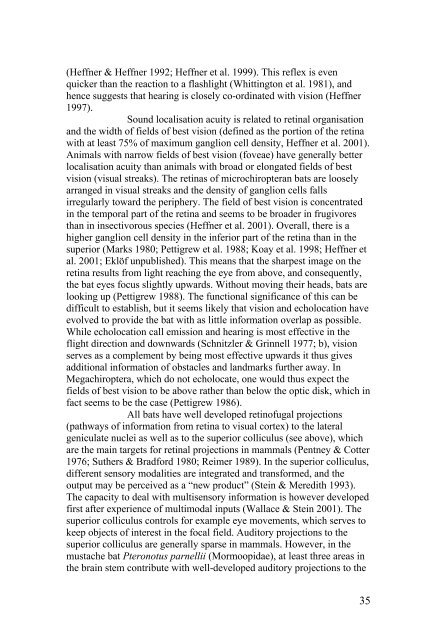Vision in echolocating bats - Fladdermus.net
Vision in echolocating bats - Fladdermus.net
Vision in echolocating bats - Fladdermus.net
Create successful ePaper yourself
Turn your PDF publications into a flip-book with our unique Google optimized e-Paper software.
(Heffner & Heffner 1992; Heffner et al. 1999). This reflex is even<br />
quicker than the reaction to a flashlight (Whitt<strong>in</strong>gton et al. 1981), and<br />
hence suggests that hear<strong>in</strong>g is closely co-ord<strong>in</strong>ated with vision (Heffner<br />
1997).<br />
Sound localisation acuity is related to ret<strong>in</strong>al organisation<br />
and the width of fields of best vision (def<strong>in</strong>ed as the portion of the ret<strong>in</strong>a<br />
with at least 75% of maximum ganglion cell density, Heffner et al. 2001).<br />
Animals with narrow fields of best vision (foveae) have generally better<br />
localisation acuity than animals with broad or elongated fields of best<br />
vision (visual streaks). The ret<strong>in</strong>as of microchiropteran <strong>bats</strong> are loosely<br />
arranged <strong>in</strong> visual streaks and the density of ganglion cells falls<br />
irregularly toward the periphery. The field of best vision is concentrated<br />
<strong>in</strong> the temporal part of the ret<strong>in</strong>a and seems to be broader <strong>in</strong> frugivores<br />
than <strong>in</strong> <strong>in</strong>sectivorous species (Heffner et al. 2001). Overall, there is a<br />
higher ganglion cell density <strong>in</strong> the <strong>in</strong>ferior part of the ret<strong>in</strong>a than <strong>in</strong> the<br />
superior (Marks 1980; Pettigrew et al. 1988; Koay et al. 1998; Heffner et<br />
al. 2001; Eklöf unpublished). This means that the sharpest image on the<br />
ret<strong>in</strong>a results from light reach<strong>in</strong>g the eye from above, and consequently,<br />
the bat eyes focus slightly upwards. Without mov<strong>in</strong>g their heads, <strong>bats</strong> are<br />
look<strong>in</strong>g up (Pettigrew 1988). The functional significance of this can be<br />
difficult to establish, but it seems likely that vision and echolocation have<br />
evolved to provide the bat with as little <strong>in</strong>formation overlap as possible.<br />
While echolocation call emission and hear<strong>in</strong>g is most effective <strong>in</strong> the<br />
flight direction and downwards (Schnitzler & Gr<strong>in</strong>nell 1977; b), vision<br />
serves as a complement by be<strong>in</strong>g most effective upwards it thus gives<br />
additional <strong>in</strong>formation of obstacles and landmarks further away. In<br />
Megachiroptera, which do not echolocate, one would thus expect the<br />
fields of best vision to be above rather than below the optic disk, which <strong>in</strong><br />
fact seems to be the case (Pettigrew 1986).<br />
All <strong>bats</strong> have well developed ret<strong>in</strong>ofugal projections<br />
(pathways of <strong>in</strong>formation from ret<strong>in</strong>a to visual cortex) to the lateral<br />
geniculate nuclei as well as to the superior colliculus (see above), which<br />
are the ma<strong>in</strong> targets for ret<strong>in</strong>al projections <strong>in</strong> mammals (Pentney & Cotter<br />
1976; Suthers & Bradford 1980; Reimer 1989). In the superior colliculus,<br />
different sensory modalities are <strong>in</strong>tegrated and transformed, and the<br />
output may be perceived as a “new product” (Ste<strong>in</strong> & Meredith 1993).<br />
The capacity to deal with multisensory <strong>in</strong>formation is however developed<br />
first after experience of multimodal <strong>in</strong>puts (Wallace & Ste<strong>in</strong> 2001). The<br />
superior colliculus controls for example eye movements, which serves to<br />
keep objects of <strong>in</strong>terest <strong>in</strong> the focal field. Auditory projections to the<br />
superior colliculus are generally sparse <strong>in</strong> mammals. However, <strong>in</strong> the<br />
mustache bat Pteronotus parnellii (Mormoopidae), at least three areas <strong>in</strong><br />
the bra<strong>in</strong> stem contribute with well-developed auditory projections to the<br />
35


